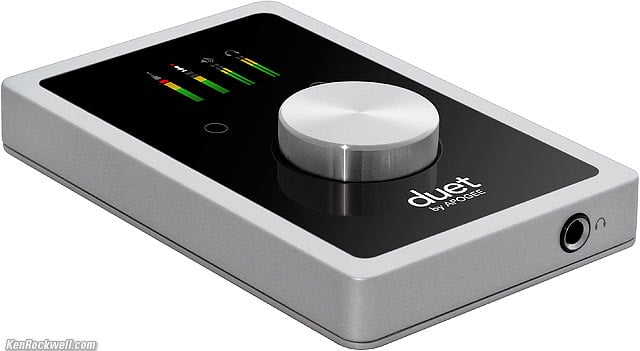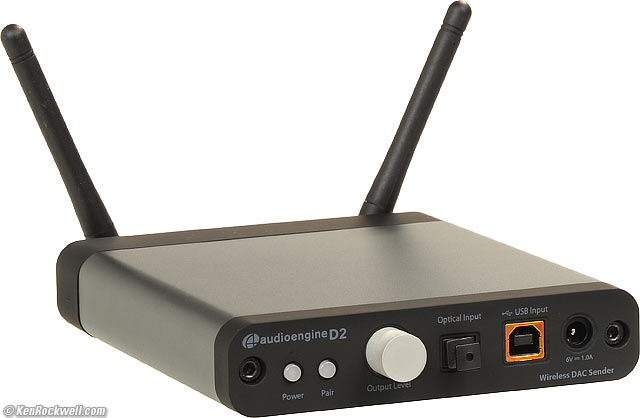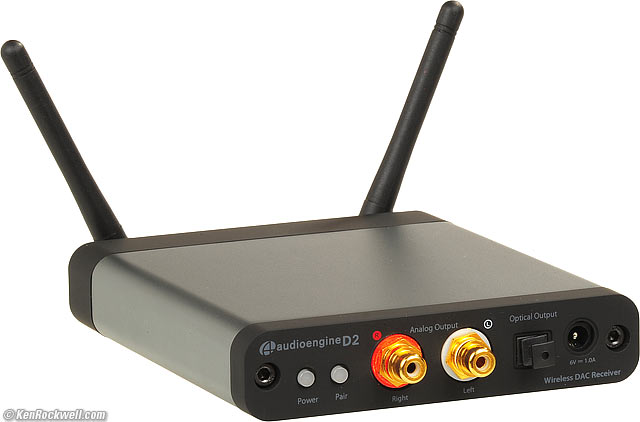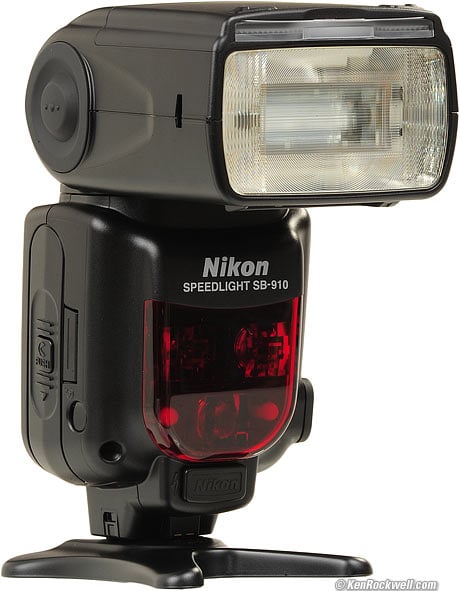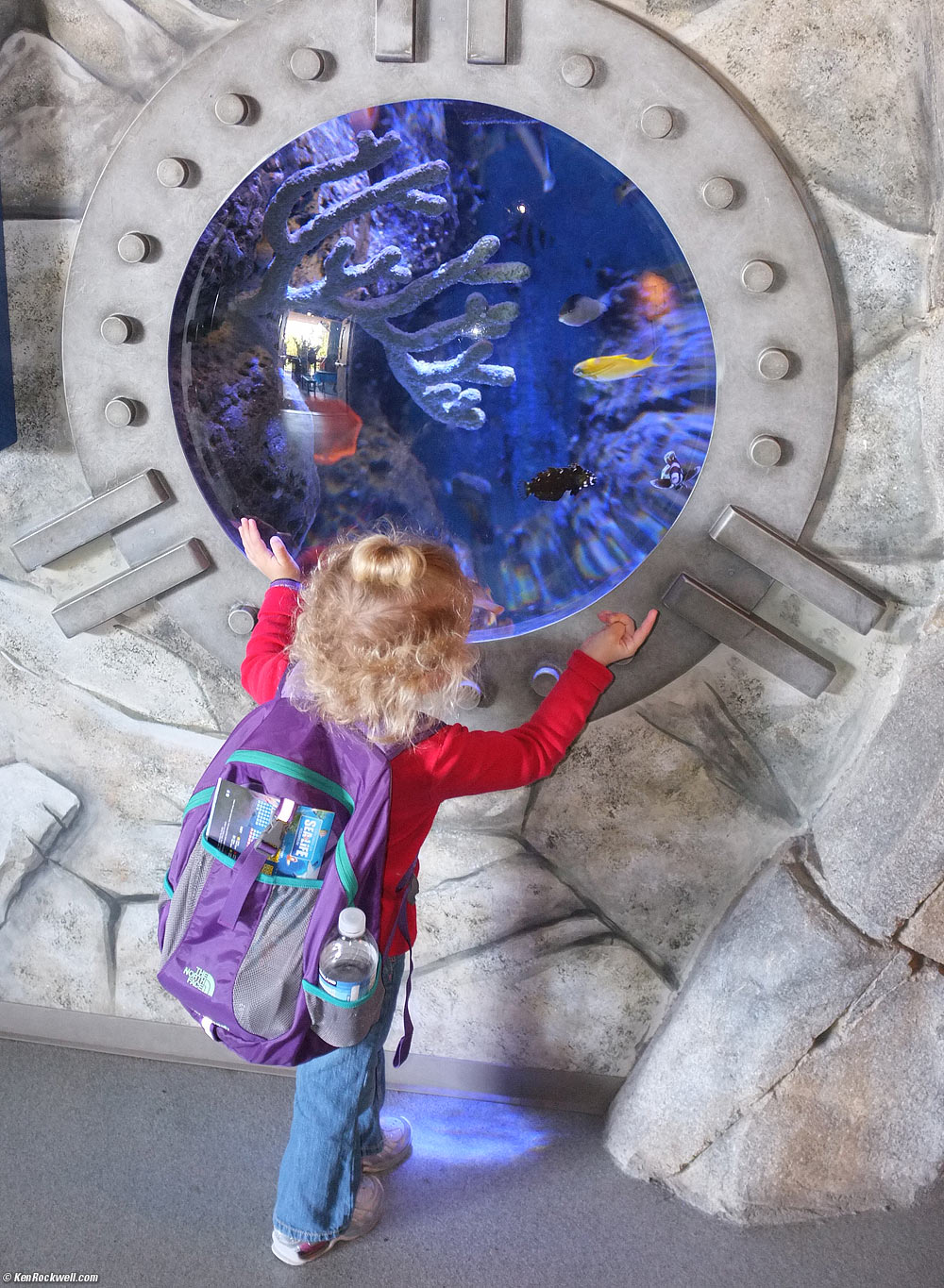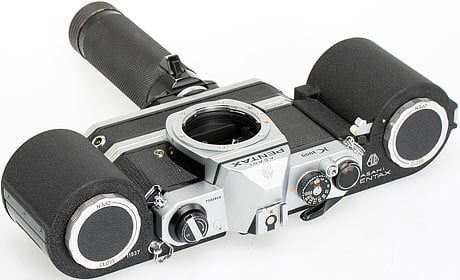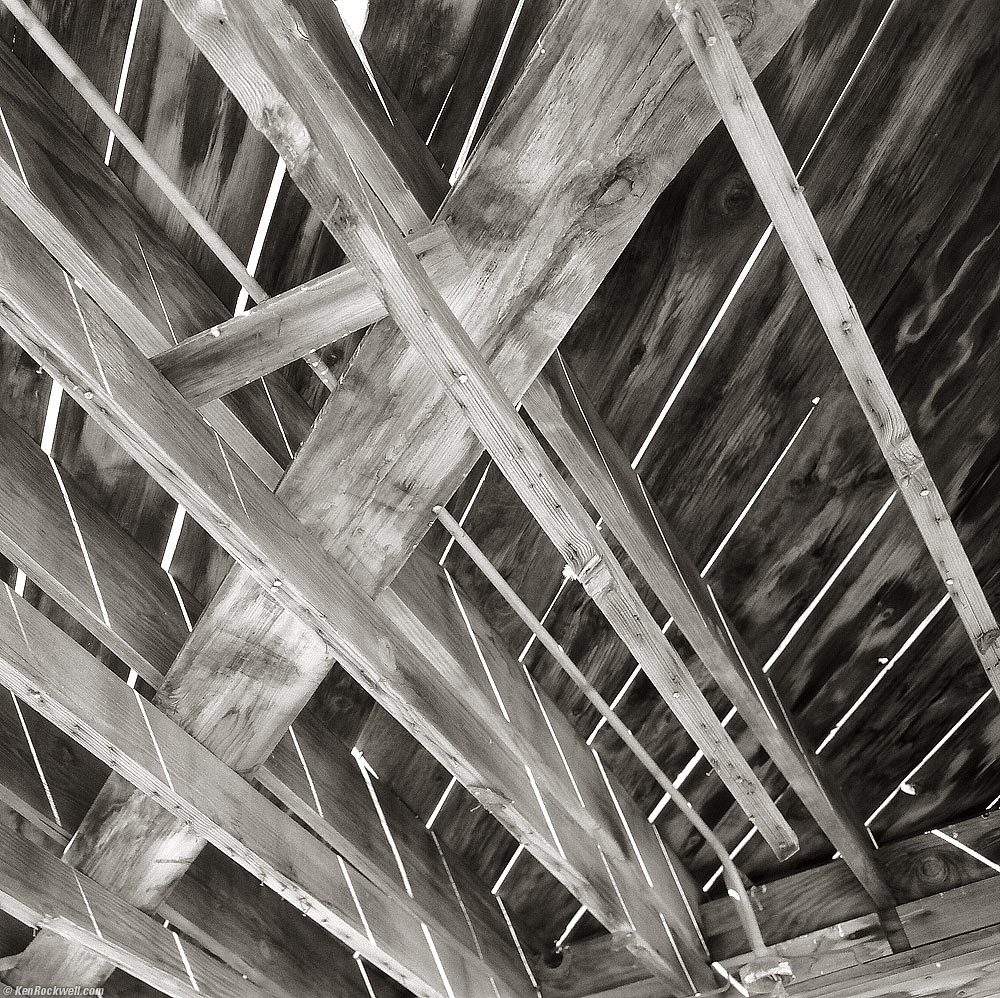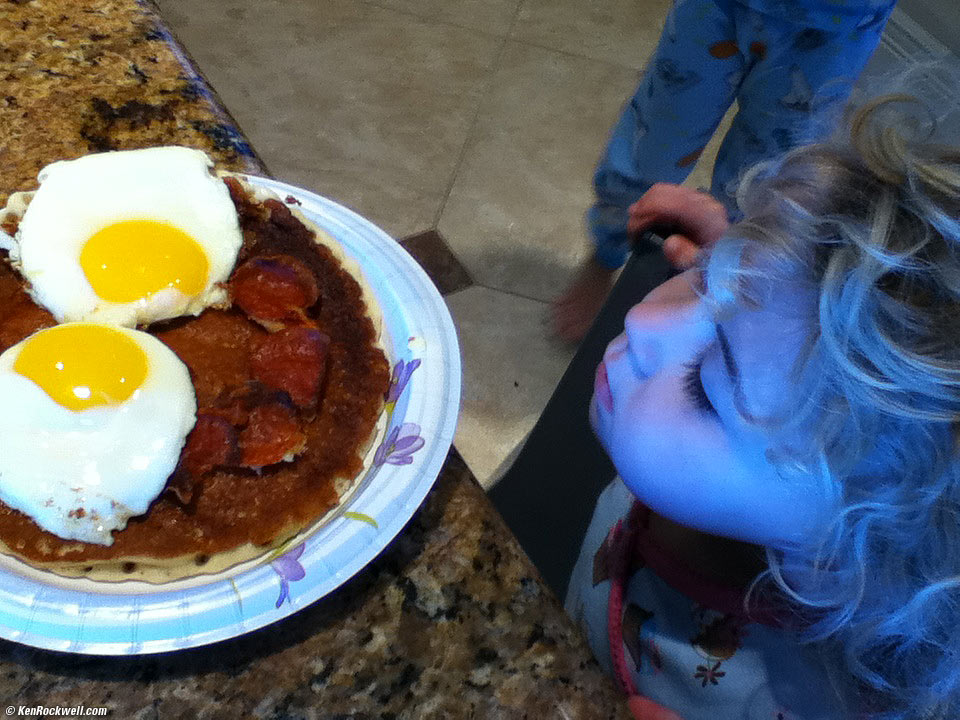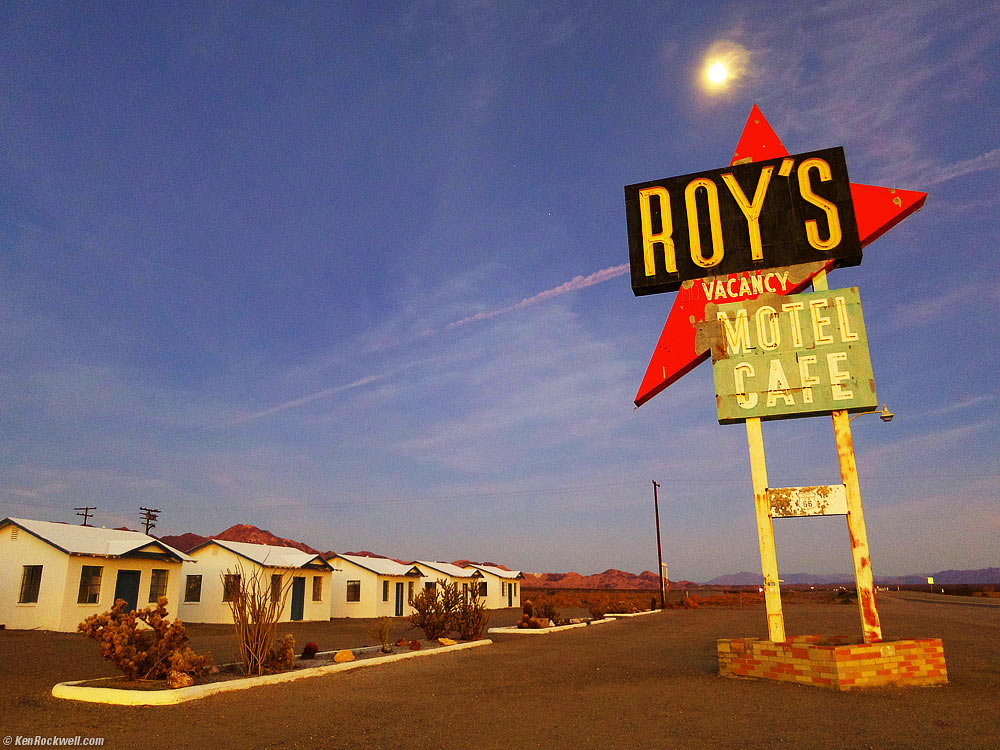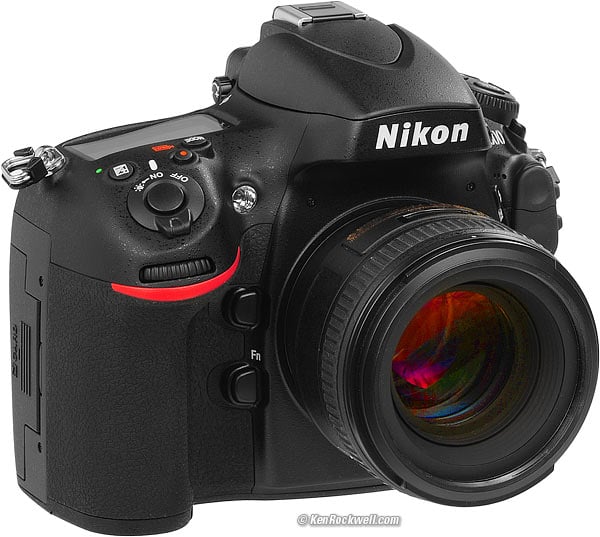Home Donate Search Gallery Reviews How-To Books Links Workshops About Contact
February 2012's News Hot Deals
RSS: daily (continuous live updates)
all © 2012 KenRockwell.com. All rights
reserved.
Nikon Canon X100 LEICA More Reviews random Ryan Katie
Recommended Cameras How to Take Better Pictures
NEW: Enter my Photo Contest to win an iPad - FREE!
Twitter Facebook Video Tutorials
|
Adorama pays top dollar for your used gear. I use these stores. I can't vouch for ads below. |
29 February 2012, Leap Year
Freedom Returns to American Forests
I just learned that the illegal "adventure pass" program will be ended. Adventure passes were a scam that prevented many of us from using our public lands.
"Adventure passes" was a name given to a scheme where a government organization had been illegally attempting to charge Americans for using our own national forests. The money was used to benefit that organization, not the forests, which as mostly wilderness, obviously need no money.
Americans already pay taxes to support rangers and everything else in the national forest system. The adventure pass scam was totally illegal, and from what I just heard on the news, the perpetrators have finally been brought to justice.
Hallelujah, Freedom reigns! In this one isolated case, Freedom is free for a change — but someone had to prosecute this crime for our benefit. Thank you!
28 February 2012, Tuesday
Nikon 85/1.8 G
I'm expecting mine today, review coming soon.
Headphone Impedances
I just compared 32 Ω and 600 Ω versions of the Beyer DT 880.
As hoped, they sound the same, just louder or softer.
The reason to use the less-sensitive 600 Ω version with high-performance gear is because the higher impedance is less likely to increase distortion or cause frequency-response abnormalities in most gear. The headphone's performance doesn't vary, but the performance of most ordinary headphone amplifiers will, unless you've got something state-of-the-art like the Benchmark DAC1 HDR (review coming soon).
27 February 2012, Monday
Canon G1X in-stock
Canon's ship just came in this afternoon, so Adorama got their pile of Canon G1X, and they'll be shipping our (and my) backorders today.
28-300mm VR & D800E: Worth it?
A reader asks if the 28-300mm VR is good enough to see the difference between the D800 and D800E.
It certainly is. The 28-300mm VR is a great lens. Nikon has learned a lot about making zooms these past 50 years and hasn't done much in fixed lenses for 30 years, and yes, the 28-300mm VR is a top-shelf lens.
If you know what you're doing, the 28-300mm VR will be sharper on the D800E, and it will excite unremovable aliases (moiré) on the D800E, too.
As with all lenses, you might see the sharpness difference between the D800 and D800E shooting the 28-300 VR at 100% on your monitor, but won't see it on prints any less than a few feet wide — but you will see any moiré in any size print.
People get all excited about lens sharpness, but there's not as much difference between lenses in actual shooting as I can show in lab tests. In the real world of motion and three dimensions (that's four dimensions), we have two more dimensions to screw up an image from the two flat, stable dimensions we use in testing.
Lenses vary the most at their corners and at maximum (wide-open) aperture, so that's where I focus (ha ha) my attention when comparing them. Little or nothing of value in a strong image is in-focus at full aperture, and certainly not in the corners. Where it matters (in the center at normal apertures), most lenses look the same regardless of how they test at the extremes.
Of course if you look at images at 100% on-screen, which is similar to about a seven-foot-wide (2 meter wide) print, you will see differences, but most of the time, you'll be seeing differences in your own technique and subject motion more than the limitations of your gear.
Specifically, diffraction will be limiting your resolution by f/8 at 36 MP! This means that any time you stop down to f/8, f/11 or smaller, which Nikon DSLRs usually do in daylight, your aperture is limiting the resolution to fewer megapixels than the 36 MP of the D800! To get the resolution you want, shot at f/5.6 or wider, which requires flatter subjects.
Diffraction is the same as the effect we get when squinting our eyes: squint too far, and it gets fuzzy. On the D800 as seen at 100% on your monitor, noticeable softening occurs with a good lens at f/5.6!
Yay, on my 18 MP LEICA M9, it's so sharp that I can see diffraction-induced blurring even at f/5.6. You'll see its effects at larger apertures with great lenses before the actual limit, which is f/8 on the D800, and f/11 on the M9.
Diffraction limits the resolution to not more than 200 lines-per-millimeter (lpmm) at f/8, which is the pixel spacing of the D800. The bad news about diffraction is that this means that MTF drops to zero at 200 lpmm at f/8.
At f/5.6 and f/4, MTF is also affected at 200 lpmm, which lowers sharpness at 200 lpmm. It takes a great lens to hit 200 lpmm, and it takes a moderate to large aperture to do it, and you have to be in perfect focus. Depth-of-felid is zero when you start looking this closely, with a blur circle of 0.0005mm or 0.00002" (0.02 thousandths of an inch), not the 0.03mm used to calculate depth of field tables.
Tripods aren't needed in daylight; since f/5.6 is the smallest aperture you'd want to use, shutter speeds will be faster.
This is why pocket digital cameras don't stop down below f/8, even if they have manual settings: their much higher resolution (per millimeter of sensor size) sensors would show the softening.
D7000 versus D800
If you have the D7000, why would you want a D800?
One of the two real reasons is the huge viewfinder. The full-frame D800 has a much larger finder than the half-frame D7000.
Even though magnification percentages look similar in printed specifications, you have to realize that the D7000's finder covers only half the frame area of the D800. Nikon deceptively specifies DX finder magnifications with a 50mm lens, even though a 50mm lens is a telephoto on DX! That's how they hide the fact that DX cameras have wimpy finders.
The other reason is low-light sensitivity. Larger sensor cameras collect a lot more light, and work much better at high ISOs. My D7000 is merely OK at high ISOs compared to full-frame, while my full-frame D3 is awesome.
In actual picture taking, the photos will look the same 99% of the time, the biggest difference being a little less depth-of-field in the full-frame shots.
So why then the D800?
Do you want a great camera, or do you want great pictures?
If you want a great camera, which is usually the case if you're like me and are reading this page each day, of course we want the D800. When you're close to your gear and use it all the time, we appreciate the best.
Honestly, the D800, D800E and D4 aren't going to take pictures any different than you've gotten before (although the speed of the D4 will help action shooters; at 10 FPS, each frame is completely different when shooting action).
Some of just like having the best, and tools which make it easier for us to make pictures. See Is It Worth It.
If all you want are great photos, you're far better off with a basic camera like a D3100, taking a few art classes and getting out there shooting than you are working more overtime to try to pay for a heavier camera that you'll use less.
On the other hand, most of us live by our cameras, and if we're out with them in Yosemite half the time, of course we want the best and newest. That's what makes us human — just don't try to sell me on the "but it will take better pictures" excuse.
Like Porsches, we buy D800s because we want them, not because we need them. Let's face it; are we really going to show up at the line-up at The Watchman in Zion, Tunnel View in Yosemite, Dante's View in Death Valley and try to look cool in front of the other photographers with a D7000? Not anymore.
Nikon always names the mainstream camera for most photo club enthusiasts as "8."
First it was the N8008 in the late 1980s. Everyone in my photo club had one. Then the N80 came out and replaced it. Then digital happened, and the D80 was hot stuff. Now it's the D800. It's always Nikon on the eights.
LEICA M9: The best is always a bargain
The resale value of the LEICA M9 amazes me. I just checked, and the M9 that has sold new for $7,000 since 2009, sells used for about $5,500 today.
That means that for the past two years, it's only cost $1,500 to run, or $750 a year.
Not bad, especially considering that the joke Nikon D3X that sold for $8,000 only sells used for about $5,000, costing $3,000, or $1,500 a year if you bought one instead of stepping up to LEICA as I've been suggesting.
If you chose LEICA, the LEICA M9 is still current, while the D3 series is history. Of course products are still sold new from stock long after factory production is stopped. (The M9P is the same camera with a different cover.)
24 February 2012, Friday
D800: Game-Changer or Same Old Thing?
A reader asks how I can say totally different things each day.
Easy: they refer to different things.
The Nikon D800 is a game-changer: after a decade of Canon always making the world's first and/or highest-resolution full-frame practical DSLRs, Nikon comes from out of nowhere and completely blind-sides Canon into the sidebars of history.
The old Canon 5D (2005-2008) always had better sharpness than today's D700 and D3S. As of 2008 with the introduction of the superior 21 MP Canon 5D Mk II, Nikon has been off crying in a corner as all the serious nature, portrait, wedding, video and landscape shooters have been using the 5D Mk II instead of Nikon's heavy, olde-fashioned DSLRs.
The 21 MP 5D Mk II has always been worlds ahead of Nikon. (The Nikon D3X was a joke-priced non-player, a pretend product that cost more than a LEICA, so people like me simply upgraded to LEICA instead. I love my LEICA M9, thank you Nikon!)
So finally, with the D800, Nikon has come out of the closet of shame and finally has a competitive camera against LEICA and Canon. With this one camera after ten years, Nikon has finally climbed to the top of the full-frame DSLR heap for everyone.
Nikon could have made the D4 36MP and the D800 16MP and we all would have bought the D800 anyway, but Nikon must have fallen asleep, because they made the camera for which we've all been waiting, the 36 MP D800, and priced it the same as the old D700. Whoo hoo!
That's game changing: Nikon finally is in the lead for the first time ever after 10 years of shame after Canon's first full-frame DSLR cameras. When Canon introduced the world's first practical full-frame DSLRs, Nikon poo-pooed the idea and told us to ignore full-frame and just keep buying DX for pro use.
However, the camera never makes the picture. The camera game has changed, but making pictures hasn't. No matter what camera we shoot, the pictures are the same. The reason buying the D800 is so important is that it makes money for Nikon that gets sent back to Japan; if you already have a Nikon D40 (or FE or SP), there's no need to buy a D800 if you just want great photos, as opposed to wanting a great camera.
The crazy level of resolution of the D800 is good to have for the same reason some people carry three guns or more: just in case. I shoot at lower resolutions, but if I need the highest resolution in case I expect to need a huge print, the D800 always gives me the option that no other real Nikon DSLR ever has. That's the real reason resolution matters, and since it's free in the D800 for the same price as the D700, it's a no-brainer.
I rarely shoot DSLRs except in my studio for macro; the camera you'll see around my neck every day is my Fuji X100, which handles real-world lighting much better than any other digital camera from anyone. Resolution? I aways shoot my X100 at Medium 3,072 x 2,048 pixel (6MP) resolution.
The Camera Never Matters; the same old thing.
22 February 2012, Wednesday
D800 Lens Mania: What's Old Is New Again
The more impressionable are all wigged-out over the extra resolution of the Nikon D800, as if it's going to change anything.
Nope. The D800 isn't even double the linear resolution of the old and crummy D700 and D3S we're all been using, and the same as the D7000. No big deal - unless you're Nikon or a store trying to sell a lot of new lenses to the innocent.
I'm going to shoot my D800 with my 28-300 VR and 16-35 VR, and that's it. In the studio, I'll use my 200mm f/4 AF-D Micro — and most of the time, unless I'm shooting in Yosemite or testing lenses, will shoot at the D800's lowest resolution setting. Even at the SMALL JPG setting, the 3,680 × 2,456 (9MP) resolution is enough resolution for incredible 40 x 60" prints — if you know what you're doing. If you don't, you'll get soft results even at the 36 MP setting. I've seen great 40 x 60" prints made from 6 MP cameras, specifically, from the Nikon D40 and the Nikon D50, no problems.
Even shot at full resolution, your photo skills and technique will have far more to do with the sharpness of your photos than your lens or camera.
I've been telling you all this since the 1990s, and it's still the same.
Yes, you can shoot hand-held and get awesome results if you know what you're doing, and if you don't, you'll still be getting dull, fuzzy results with a tripod by shooting at the wrong apertures in the wrong light.
Tripod hazard number one is shooting at small apertures. f/22 is sharp on a 4x5" camera, but diffraction makes it soft on 35mm. f/5.6 will be optimum on the D800, as it is on the D7000 — but only if the subject is flat or at infinity. How do you figure out the optimum aperture if your subject isn't flat? It's nearly impossible, but I worked this all out in the 1980s and published the answers in the 1990s.
See also How to Get Sharp Pictures.
After all this, if you demand the very sharpest lenses I've ever tested for Nikon in their focal lengths, these are the 16-35 VR, the 24mm f/1.4, the Voigtländer 40mm f/2, 60mm f/2.8 AF-S Micro, 105mm VR Micro and 200mm AF-D Micro.
I own all these for what they do best, but when I'm out in the field shooting, the only two FX lenses I take are the 28-300 VR and 16-35 VR. In actual shooting of 3D targets in real life, my 28-300mm VR is the same as the other lenses, and most importantly, I don't miss any shots while my back is turned changing lenses.
See also Assembling a System, which clarifies never to carry two lenses which duplicate each other's function.
If you're a cheapskate, Nikon Cheapskate Lenses gives away the secrets of which old, used manual-focus lenses have stellar optical performance on the D800, however, the smart money always buys whatever lenses you really want. Lenses are forever; whatever you get today will be serving you well in 10 or 20 years, while your D800E will long have been thrown away.
20 February 1962, First Free Man in Orbit
USMC Colonel John H. Glenn
50 years ago today, the world's first free man orbited the earth.
17 February 2012, Friday
Nikon D800 Lenses
You've all been asking, so I expanded my section on Recommended Lenses for the Nikon D800.
WPPI Specials
In celebration of the WPPI trade show, Adorama has TWO PAGES of specials, Page one and page two.
Online Learning
Friend of a friend Phil Steele just wrote me, and he now has a slew of online training available about everything from portrait shooting, Photoshop and Lightroom. He's even got plenty of free things, too!
Photo Apps
I just added Darkness and Time to the list of Suggested Photo Apps I use.
Apogee Duet 2.
NEW: Apogee Duet 2 Review.
The Duet 2 is the best-sounding and most ergonomically brilliant DAC and headphone amp I've yet heard for desktop and computer use.
It's a professional 24-bit/192k DAC, headphone amp, monitor controller and recording ADC, made by the same company whose ADCs have been used to record about half of the music that's won Grammy awards for the past couple of decades. It sounds great, and sells for only $595, a no-brainer for my desktop system.
I have more DACs here for review after CES and NAMM, and I doubt any of them will work better than having this nice, big knob on my desktop to control both my speakers and my headphones separately.
It's great to have something Made in USA to review for a change!
I'm still waiting for my Nikon D800 and all the other new photo goodies to arrive, too. This is going to be a great springtime!
audioengine D2 transmitter (top) and receiver (bottom).
NEW: audioengine D2 Wireless DAC Review.
Much better performance than expected, and it does it all without wires so you can put the DAC's output at your main system, and control it from your listening position or your desk.
Sony SCD-XA777ES.
NEW: Sony SCD-XA777ES Review.
10 years old, and still better than an external DAC, because any jitter that happens inside a 1-box CD player stays inside that CD player. Jitter is only a problem when you try to run digital signals from one box to another, and don't have the DACs synchronized with an external word clock. Consumer DACs have to try to extract embedded clock signals from the audio data itself, since the reference clock signals don't leave consumer players.
Mahler, El Sistema and the LA Philharmonic
One of our readers is down in Venezuela, playing in the Los Angeles Philharmonic's Mahler Project along with El Sistema, getting kids into music instead of less appropriate activities.
He's got his Nikon D3 along with his axe down in Caracas, and sharing the photos at his site.
Old: How to Win at eBay
I was looking at some statistics, and if I read them right, I was ashamed to see that only about half the bids I think you readers place actually win on eBay.
I win 99% of everything on which I bid, and usually pay much less than my bid amount.
I think some of you need to read my classic How to Win at eBay and most importantly, need to stop bidding at any time other than the very last second.
The last bidder wins. Let that be you. The only thing bidding before the last second does it up the price for the guy who actually does win.
15 February 2012, Wednesday
NWF Photo Contest
The National Wildlife Federation's annual photo contest is open again. Here are last year's winners.
You can start entering today, and it closes 16 July.
Each year I see the best wildlife images anywhere winning this contest. National Geographic and Arizona Highways don't do it this well; the NWF brings out the best there is in wildlife photography.
Waiting for the Light
Nature shooters don't just walk up to something scenic and snap away. They plan for weeks or years to get the right light, and wait patently, watching weather reports and chasing storms. You can't get what they do by just going out one weekend and hoping for the best.
For instance, Michael Fatali, among the world's greatest photographic artists, lists as one of the most critical aspects of each of his photos how long he had to wait for the light.
Shooting on 8x10," you've really got to see his prints in person to appreciate them. His work is mighty enough to look great as thumbnails online, while even mural-sized they still have three-dimensional detail. You can't do this on digital, and you can't do any of this if you aren't paying attention to the basics.
A reader brought up an interesting point about the judging: since your work needs to be voted among the very top 25 entries in order for it to be considered at all for judging, it behooves you to enter sooner, rather than later, to collect the most votes.
One factor to try to ameliorate a bit of that is that there's a Recently Added display, but all the older entries appeared there, too.
If I were you, this is not a contest to await around until the last possible moment to submit. This is New York and this is a competition, and the sooner you enter, the better.
Judging tip: I get into this in my workshops, which is that a great photo is a great photo even seen as a thumbnail. When I say that I'm awarding the free iPad to the strongest image, that means that I'll probably judge all the images only as thumbnails! Here in New York, you've got to be strong to survive and a lot stronger to win, and that means that your image has to be loud and strong enough to say "Pick Me!!!" even in a sea of thumbnails.
90% of making a great image is getting the basics right. Few photographers pay any attention to basics since, unlike painters, the camera always captures something, even if you pay no attention to the basics. Most photographers ignore the basics, and thus make boring, bland images that say nothing thumbnail-sized.
In the real world, images rarely get any bigger than a thumbnail, and even when clicked to enlarge or printed, rarely bigger than iPad sized.
The key to winning this contest is to craft an image with such strong basics that everyone will be attracted to your image as a thumbnail. That's 90% of life in photography.
As a pro friend who shoots for Arizona Highways told me decades ago, an image needs to be strong enough that it's the one that an editor will pick while spread-out on a light table with all the other competing images.
Be it on a real light table or an online gallery, 90% of winning is making an image that has a strong enough fundamental structure to stand out as a thumbnail — in well under a second.
The easy 10% is to have some interesting details once an image is enlarged, but photography makes that easy; cameras paint in all the details for free. The hard part of being a photographer is designing your image to have its basics in order, which the camera can't do.
Yes, I'll probably judge the contest in a few seconds looking at a 5 x 5 matrix of 25 thumbnails. First impressions are important, because in today's distracted Internet age, if your image doesn't impress enough as a thumbnail in the first tenth of a second, no one will probably ever see it again. With digital, every idiot is out making 1,000 images a day, so your images need to be so well edited and so strong that even King Kong will come off the Empire State Building to come check it out. Hopefully there will be enough in your image, once King Kong, the alligators and I come over to see it, to keep our attention, but catching a viewer's attention is the most difficult part.
This is why any camera can be used to win; the critical basics sing through even shot with toy cameras.
Good luck! Shoot strong! No wimpy snaps!
Nikon SB-910.
NEW: Nikon SB-910 Review.
Nikon's top flash.
Nikon 220º Fisheye
I see a Nikon 6mm f/5.6 220º fisheye for sale on eBay, for only $4.995.95. This is the fisheye similar the 180º 7.5mm f/5.6; you have to lock-up your mirror. Folks tell me that it's no big deal to flip up the mirror with your finger on a DSLR as you insert the lens if your camera lacks a real mirror-lock-up.
Better than using a 35mm SLR or the included DF-1 viewfinder, if you have Live View, you can see all 220º!
It's a Buy it Now, so if you want it, buy it now. More about how to win on eBay, and how to win at buy it nows.
Tokina Deal
Tokina 12mm-24mm f/4.0 PRO DX Auto zoom lens for Nikon $449
14 February 2012, Valentine's Day
Fuji X100!
Katie, fill-flash and ambient light at Auto ISO 2,500.
You know how much I hate my X100 for low-light. It smokes all my DSLRs, not only for low noise, but also for it's ability to tame harsh light, add fill flash and set auto white balance perfectly on each first shot — no looking at an LCD and trying again with different settings needed.
While aquaria frown on flash, the fill-flash of the X100 is so soft that it's not a problem because it's not really flash. The X100 dims its flash so far down in low light that it looks like a fast AF assist light, and is also why it balances with ambient light so well — and why aquarium staff encourage its use.
Katie got a new backpack this morning, and wanted me to blow off work and go play — and so I did! (A huge advantage of these difficult economic times is that I haven't had a job since 2004!)
Anyway, as always, my X100 shots at whatever ISO it wants to grab, even with flash, all come out perfectly, no noise, and perfect exposure every time; something non of my Nikon or Canon or LEICA cameras has ever been able to do (LEICA doesn't even try to do fill-flash).
Hand camera to wife: perfect white balance and fill-flash in dark restaurant at Auto ISO 3,200.
Sure, I'm salivating so much I need refills for the napkin dispenser here in my "office" as I await my D800 for landscape and nature photos where I need insane colors, but for family photos, my lightweight Fuji X100 is God's gift to photography for those of us who actually shoot in real (crappy) light as opposed to shooting test charts in some studio in Switzerland with purified air and regulated high voltage power supplies. Put your X100 on your Christmas list today if you have kids.
Upcoming Workshops:
This Weekend: 16-19 February 2012: Yosemite in Winter (Thursday-Sunday).
I won't be on this one simply because my kids are starting to miss me while I'm out on these things, however I got the best B&W shots ever last year on this trip, so I wanted to let you know about this trip, too.
Call or eMail Dave (323) 377-7565 for registration or more information, and let Dave know I sent you.
In a couple of weeks: 02-04 March 2012: Olde Southern California (Friday-Sunday)
I'll be on this one!
We'll be exploring the backroads and less-often seen olde missions of historic Southern California.
Call or eMail Dave (323) 377-7565 for registration or more information.
17-20 May 2012: Spring Light Photography in Yosemite
I won't be on this one again because my kids are really starting to miss me, however I was on this trip last year, so I wanted to let you know about this great trip, too.
If you want waterfalls, this is your trip! The falls usually run like crazy in springtime.
Dave Wyman is teaching this one, but you register for it with the Yosemite Conservancy. Tell them I sent you!
Valentines Day
The best gift you can get your wife is the great kid pictures you'll get with a new D800. Go ahead — she wants you to get it — and you will if you do!
New Canon Lenses
Canon sent this out an hour after Nikon announced the D800 last week, so I was distracted.
This is a classic fixed 28mm f/2.8, with Image Stabilization.
7 blades. 0.23m close-focus, 58mm filter thread. $800.
Why would we care, especially since the 28mm f/1.8 sells for less? I'd care a lot if this lens had stellar, LEICA-like image quality, which none of Canon's zooms possess.
Canon EF 24mm f/2.8 IS USM Lens
This is a classic fixed 24mm f/2.8, with Image Stabilization.
7 blades. 0.20m close-focus, 58mm filter thread. $850.
Likewise, this will be big news if image quality is spectacular, which I suspect it will be, as Canon knows what it's doing, and wouldn't introduce a chump of a 24mm lens if it didn't way outperform every other 24mm IS zoom.
Canon EF 24-70mm f/2.8L II USM
9 blades (YAY!), 82mm filter (nay!), $2,300; cheap for a lens with which you can earn your living for the next 20 years.
This is the new version of one of Canon's most popular lenses, the superb first 24-70mm f/2.8 L USM. Neither of these 24-70s have Image Stabilization.
12 February 2012, Sunday
D800 Saves on Lens Purchases
Remember ten years ago when digital camera makers tried to get us to spend more money than necessary to get us to pay for extra megapixels so that we had extra pixels so we could crop safely?
Back in 2002, camera makers used FUD to try to scare everyone to pay more for 4 MP, or even 5 MP cameras, even though 2 or 3 MP was more than enough? Heaven forbid if you needed to crop! If you didn't pay extra for 4 MP, you supposedly were screwed. (Baloney, in 2010 we blew up a slew of 2MP images to 16x20" for a funeral, ad they looked awesome — but we didn't crop, hee hee.)
Now have you noticed how camera makers try to get us to forget all this, since obviously with 36MP, we could crop so far that we don't need to buy any telephoto lenses!
It's true! Starting with 36MP, you can crop to only one-quarter the height and width, and still have well over 2 MP left! The D800 is 7,360 × 4,912 pixels, so crop only one-sixteenth the image (one-quarter the height and width) and you still have 1,840 x 1,228 pixels left, more than enough for a full-resolution 100 DPI 12 x 18" (30 x 45 cm) print or on-sceen image.
With the D800, you've got the potential for a 4x digital zoom, without losing any sharpness, presuming you've got a good lens like the $130 Nikon 50mm f/1.8 D. With this $130 50mm lens, you've got the ability to crop-in to at least the equivalent of a 200mm, f/1.8 lens for 12x18" prints! If you publish mostly online and print smaller, you can crop to the equivalent of a 400mm f/1.8 lens, no problem!
That's one of the reasons 36MP is good. I pulled this digital zoom trick in Yosemite this summer, using my 30-year-old 90mm lens to fill in for a 300mm lens, from only 18MP, with perfect sharpness.
Even better, you don't have to crop from the center. Back in the 1950s, newsmen shot 4x5" Speed Graphic cameras. They didn't need long lenses shooting sports; they had such a huge, high-resolution negative that they could find and crop-out the relevant composition from the full frame later. They really could spray-and-pray, since someplace in the cluster of players a high-resolution perfectly-framed image awaited later discovery.
Nikon won't tell you this anymore; they want you to buy the $2,400 70-200mm VR II, and miss half your sports shots when you're pointed in the wrong direction or miss focus. Shorter lenses get much more in focus much more quickly than long lenses.
If you want shallow depth-of-field, long lenses are the way, but for everything else, screw Nikon; shoot with a shorter lens and save yourself the headache.
11 February 2012, Saturday
D800 Changes the Game
I'm so looking forward to the D800. Actually, I'm opting for the D800E because I test lenses for a living. For normal people, the D800 is the way to go, especially if the price matters. 36 MP is more than triple the resolution any rational person needs for anything.
As you know, I've been waiting for the D700X, which was cancelled so we would have to buy the overpriced D3X, so now four years later, we finally get the high-resolution version of the D700 for which we've all been waiting. It's about time, and getting 36MP makes up for the wait.
Some people are afraid that the D800 won't look good at high ISOs. Au contraire, if you look at my Nikon D3X versus Nikon D3 ISO comparison, what common men seem to forget is that at a given ISO and print size, the two are the same! In fact, the noise is the same, while the D3X image still has more resolution at ISO 6,400. The D3X and its higher resolution wins big time over the D3 and D700, but at $8,000, Nikon can keep them.
Having more pixels allows you the choice of ultra-resolution for huge prints or crops, and when displayed at reasonable print or screen sizes, the natural downsampling gives the same noise advantage of having fewer, larger pixel wells. If you've got three times as many pixels, the noise cancels the same way it does when you have larger wells, so it's a non-issue. The D800 will work great at high ISOs!
While less experienced people might worry, the key here is that having more pixels than you need is a very good thing, because it gives you options. You can't shoot a D700 at 36 MP, but at the same ISO and resolution, the D800 ought to smoke the old D700.
I never got excited about the D3X because it was priced by Satan himself to rip us off just because Nikon thought it could, and all that did for Nikon was convince me to upgrade to the lower-priced LEICA M9 and its superior lenses, and I'm glad I did!
I'm very excited by the reasonably-priced D800 which completely eclipses every other Nikon camera, unless you need the speed or durability of a pro camera like the D2, D3, D4 or SP, F, F2, F3, F4 or maybe F5.
The D800 has more pixels than anyone other than a professional lens tester needs, but so does the Canon 5D Mark II. In all these cases, as well as with my D7000 and D3, I always shoot my real photos, both professionally and of my family, on the lower resolution settings. Even at their lowest settings, 12 x 18" prints still look three-dimensional. The large resolutions from these cameras are for printing many feet or meters wide.
So why do cameras like the D4 go to stupider-high ISOs? For marketing! The highest ISOs of cameras like the D4 simply look much crappier than the highest (but lower) ISO settings of more reasonable cameras. Cameras with six-figure ISOs simply crank the gain all the way to stupidville, and let the firmware smudge out all the details.
The higher resolution cameras don't go to the stupider ISOs not because of technical limitations, but because the marketing and product definition people defined them that way. For instance, the Canon S90, S95 and S100 have a stupid-high ISO scene mode, and to get these ridiculous ISOs, simply shoot at a lower resolution. It's all math in firmware and very little to do with sensor resolution.
High ISO performance is ultimately about magnification ratio and the cleverness of the camera's firmware used to smudge out noise but leave details alone. Large sensors don't need to be enlarged as much, so noise is less visible. Larger enlargements, needed for the same size prints from smaller sensors, make noise more visible. Start with the tiny sensor of a point and shoot, and your prints can't get very big before noise sets in.
The only reason splitting a sensor into more pixels make there appear to be more noise is if you compare both images at 100% on-screen, in which case you'll see more noise from the higher resolution sensor — because 100% on-screen is a higher magnification from a higher resolution camera. Display the images at the same print or screen size as I did years ago in my Nikon D3X versus Nikon D3 ISO comparison, and the higher-resolution sensor worked just as well at a given ISO. In fact, the D3X clearly has a sharper image, with the same noise at ISO 6,400. How about that?
If you want stupid-high ISOs not settable in a higher-resolution camera, no problem, just push ISO in Photoshop or other software.
100% on-screen with the D800 will be the equivalent of six feet (two meters) wide, which is nuts. Don't worry about noise at 100%, and if you do, so what; the D800 has the same pixel pitch as the D7000 that we all love so much. The D800 is simply the D7000 sensor expanded out to to FX.
Guess what? ISO 6,400 is enough to shoot at 1/4 second at f/1.4 in full moonlight. I have no idea why anyone actually needs ISO 25,600 or whatever, and the D800 does all this as it is.
I would have loved having a D3X instead of my D3 for everything, including low-light shooting, these past years. The only reason I didn't buy a D3X is because it was predatorily priced, and while there's nothing wrong with someone asking a high price, there is something very wrong with actually paying it.
Now that the D800 is available for exactly the same price at which the D700 debuted, I'm all over it!
D800 for all!
Forget Gray Market DSLRs
Readers write me asking what I think of the deals they got when they got a great price on a gray-market DSLR. (See how to check your box see if your D7000 is OK or not.)
I reply that these readers got screwed.
Gray market is great for things like manual-focus lenses or lens caps that will never need Nikon factory service or firmware updates, but digital cameras always need firmware updates.
Get stuck with a gray-market DSLR, and you're screwed when the new firmware comes out, because you need a USA serial number to download it — even if your shifty dealer it threw in an impressive third-party "warranty."
If you got scammed with a gray-market DSLR, send it back, and if the dealer won't take it, call your credit-card company and you won't have to pay for it.
Gray is great for things that won't require any support, but DSLRs are dead without factory service.
The New Product Cycle
This happens every time a hot new camera comes out. It happens with every one, and in fact I documented it for the Rings around Uranus with the Canon 5D Mark II.
Every time a hot new camera comes out, the day after it first ships, some tweaker discovers some way to break it. Under some bizarre condition about which no one cares, there will be a pixel shifted or banding or something irrelevant.
It gets posted on the Internet, and the whole world two days after they first start to ship is all up in arms about a shoddy product.
The manufacturer vehemently denies everything, and about a month or two later that same manufacturer fixes it all under warranty, or usually with a free firmware update.
I'm sure the same will happen with the D800. It always does.
Here's why people who get stuck with gray-market DSLRs are screwed: they won't get the free warranty update or be able to get the new firmware, and their third-party service people can't get it for them either. Run like crazy away from gray-marker DSLRs, but consider it for things that won't need service.
Never be afraid of "New Camera Bugs." I have a whole article on that.
Forget NPS Priority Purchases
Readers also ask where they should place their NPS priority orders, since the very best dealers tend not to waste their time with these.
No problem. This service might help for mature products, but for the D800, the first batch all comes off the same boat from the Orient at the same time. Every dealer gets their first D800s at the same time (see How to Get It). The real question is how many thousands of D800s does your dealer get in their first shipment?
If you place an order with a large local store or pro dealer, you might get priority, but that local store might only be allocated thirty D800s from the first boatload. That's great, but if thirty-one other NPS guys have priority there, too, you're screwed; or if they only get thirty of the thirty-three they ordered, you're screwed, too.
The best way to get yours first, as I've said over and over, is to place your order as soon as possible with the biggest dealer possible. That means The Professional's Source, B&H, which is the largest dealer in the country (or the world as far as I know), as well as the other New York giant, Adorama (where I ordered mine). Likewise, Amazon is huge and has their logistics running extremely efficiently.
The reason I ordered mine from megadealer Adorama is because they sell the most cameras, and therefore get the most cameras when the first boat arrives. Our key here is getting our D800 from the first batch off the first boat. By ordering from either of the New York giants, it's much more likely we'll get ours pronto. It doesn't matter how much priority you get from a local store if he only gets 40 D800s, while a big store might get 4,500 pieces in their first delivery.
Sure, you might get priority locally, which might get you the first camera — from the third batch that arrives sometime in early June. Forget NPS priority orders if you know How to Get It.
Get it fast
Another reason you want to have your D800 on order pronto is so that when you sell your old camera, all the other laggards aren't trying to dump theirs at the same time. When you lead, you'll be able to sell your D700 or D7000 for more money than the poor folks who wait to order their D800s, and have to sell their old cameras at the same time as everyone else.
For instance, my D3 is earning my living every day. It's not for sale, but as soon as I get my D800 and do all my comparison tests, out it goes. The pro-use cameras don't get sold until the new ones come in; we can't stop shooting while waiting for a new camera.
This is all explained at How to get it. It's the same story for every hot new camera, and the D800 is smoking hot. Every Nikon shooter wants one.
The price won't be dropping for a long time
Another reason you deserve your D800 today is that the price rarely drops for a year or more. In fact, I expect that the vacuum in a month or two will raise the street price of the D800 well over what we can order it for today.
Get your D800 today, and you'll be enjoying it for a lot longer than if you wait a year. In a year, it will still be $2,999.95, but you'll have wasted another year with your old camera whose resale value has fallen even further.
Sure, in 2014 the D800S will come out, which will be exactly the same thing with a firmware tweak or two. No big deal, but Nikon does this to have an excuse to bump the price $300 — for the same camera.
Waiting only costs you. The D700 started at $2,999.95, and today sells for $2,899.95. Sure, waiting really would have paid off!
Worse, if you waited for the D700X and never bought the D700 as I should have, in a year or two you really won't have the guts to buy a new D800, because you'll be afraid of a new camera being on the horizon. It was my own pigheadedness in waiting for the D700X all these years that denied me a D700.
Cameras are cheap. Used DSLRs still have value. Get your D800 today, and you'll get more years out of it, and when you sell yours for the D900 in 2016, the money you lose when you sell it will be spread over four years, making it almost free. Even reselling to a dealer, I've gotten 4.5 years out of my D3, and reselling the easy way to Adorama for about $1,500 means it only cost me ($4,999-1,500)/4.5 years = $3,499/4.5 years = $775 per year. If waited, there'd be fewer years in the equation, I'd have made fewer photos, and the new price never went down.
Have a D7000 and want a D800?
I get this question a lot: you've got a new D7000, and now want a D800. Should you?
Well, yes and no. As I keep telling everyone, the pictures will be the same. Cameras don't take pictures, photographers do.
Honestly, the biggest reasons to make the huge upgrade are for the much bigger viewfinder! Same thing for the D700; it's all about the huge FX viewfinder. Pixels don't matter.
Forgetting the cost, know that you'll need all new FX lenses. Sure, your DX lenses work perfectly on the D800, but that means you'll only be using the central DX portion of the sensor which just happens to have the same resolution as our D7000 or D5100, so you've accomplished nothing — and will only be seeing through the small central DX section of the D800's finder!
Also, the D800 lacks the emancipating U1 and U2 instant recall modes of the D7000. I have no idea why Nikon missed this, but that's what they get for ignoring my input on that one.
So, yes, if you like nice things, you know you want a D800, but if you go for it, you'll also be shopping for new lenses, and having to carry a heavier camera with heavier lenses.
If you're reading this page, you're one of us, so yes, you know you want a D800. You may as well get it while it's new, instead of waiting a couple of years and missing out — you know you want it (but it won't make your pictures any better).
A D800 will, however take much better pictures of your family. See my classic article Why Your Wife Wants You to Get a Fancy New Camera.
10 February 2012, Friday
Pentax K1000 with 250-exposure Motor Drive. bigger.
NEWS: World's only K1000 with Motor Drive, for sale.
Too weird!
See also a rare LEICA M2-M MOT for sale.
08 February 2012, Wednesday
I just got my film back from NCPS and added B&W shots to my route 66 trip photos. Check it out if you only saw color yesterday.
Nikon D800E
I added more details about the Nikon D800E to my Nikon D800 Review.
Nikon D3 Needed to Defend Freedom
One of you readers, US Army SPC Cory Lessard, a sniper fighting out in Iraq and Kuwait, would like to buy a Nikon D3 for about the same price as Adorama is offering for them, about $1,500.
The sand is putting a beating on his D5100, and while his F5 holds up great, it's a bear having to wait 3 weeks for the film to go away and come back again from way out there. Heck, the Apollo astronauts got their film back sooner.
SPC Lessard has 2,200 soldiers knocking on his door looking for photos to send home to loved ones.
My D3 isn't for sale since I'm using it every day at least until my D4 or D800 arrive, but if any of you have one for sale and want to help the people who put their lives on the line protecting all of use, send SPC Lessard an email.
Thanks!
Ken
Seen on eBay
White Balance gone wild
Katie and the Smiley Pancake.
Blue kids?
Simple: the eggs were lit directly under our halogen kitchen floods and the camera's auto white balance picked up on the 3,200K color for "white."
Katie was lit not by the downlight, but morning's first blue skylight, made even more blue by the camera looking for 3,200K light.
Light has direction, so pay attention. Blue came from the left and orange came from above. Neither light source lit the other parts of the subject, hee hee!
07 February 2012, Tuesday
Roy's by Moonlight, hand-held with the Canon S100.
NEW: Photos from Route 66.
What I did this weekend.
NEW: Nikon D800
It's really 36MP! Nikon wins the DSLR race and blows Canon back to 1934!
Nikon has done the honorable thing and rendered the D4 obsolete for most of us, even before the D4 shipped! The D800 is smaller, lighter and has over double the pixel count of the old D4.
Of course pros know that anything over 10 MP isn't needed for anything, and will still prefer the D4 for its speed and durability.
My D800 is already on order. If you hope to get yours anytime soon, you have to order your D800 today from Amazon, the D800E today from Amazon, order today from B&H or order today from Adorama. Products this popular are going to be very hard to find for months, so unless you order today and get on the top of the list, you'll be at the bottom of a very long list.
I've already ordered mine at Adorama. This is how I get things before everyone else; I order the first day, not the second, or a week later.
The D800 is the best DSLR ever made by Nikon by a long margin, and most of us have been waiting for years for it. I doubt Nikon has the capacity to fill all our orders for quite some time, so don't wait around and wonder why it's on back-order through October.
Order today, and you don't have to pay until it ships, and if you really hate it (not likely) you can send it back. It makes all the sense in the world to order the instant it comes out; you don't really need to make up your mind until it ships, but if you don't have it on order today, yours may not ship for many months.
I don't mean to go on about this, but every time a super-hot new camera comes out, it's sad when I get emails from the people who waited, asking what can they do to get one before their vacation. If you don't order now, you may not get your D800 until the fall. I expect it will be this popular, and that Nikon lacks the manufacturing capacity to fill all the orders that will be coming in for a very long time.
Likewise, get your 28-300mm VR today while you still can. If you wait for your D800 to arrive and then order your lens, the 28-300mm VR again will be nowhere to be found. Sorry if I sound a bit competitive, but hey, here in New York, it's a tough world, and the early bird gets the worm. I want you all to get your cameras and not be wondering what happened when they are on backorder for months. Remember the 80-400mm VR? The D200? The 18-200mm VR? All these were impossible to find for a year or more, and the street prices climbed with demand. The D800 is the same thing: a significantly better landmark new product we all need.
Goodness, I just had to rewrite half of my Recommended Cameras page. The D800 just wiped out the D3X, the D4, the D700, D700X and the D3s. The D800 has higher image quality, weighs less, and costs less. Hallelujah! Unless you're a full-time pro who needs the durability or speed for sports, the D800 has the highest image quality of any digital Nikon ever, at any price.
06 February 2012, Monday
Twitter and Facebook
Yay! I just got on Twitter. A few of you also know me on Facebook. If anyone follows, maybe I'll share fun stuff. Who knows?
Route 66
I just got back from Route 66, using my new Canon S100 (as well as my old LEICA M3).
I love the S100's compact size (especially as carried my the tiny Canon PSC-900 belt holster case), zoom range and brilliant colors, but after having shot the Fuji X100 daily for all these past months, the tiny sensor of the S100, just like all pocket cameras, really makes its limitations apparent.
The Fuji X100 really is extraordinary in its ability to grab perfect exposure and auto white balance every time, as well as have nearly limitless highlight and shadow capacity. Shooting a pocket camera for a change really makes me appreciate how far the X100 has come from all other compact digital cameras. The Canon S100 is often clipping its highlights, even shot in CR2 raw or using Canon's highlight recovery option. It's tough with the S100 to capture highlight and shadow, compared to most DSLRs or the X100. The S100's sensor dynamics are squeezed to the limit trying to keep noise at bay at the expense of highlight rendition — as are all pocket digital cameras. Film shot in a point-and-shoot has no such limitations.
Yes, the Canon S100 is the world's best pocket camera, while the Fuji X100 is still in a class by itself, with it's relatively huge sensor and triple the price of the S100. We'll see how good is Canon's G1 X big-sensor compact as soon as mine arrives.
The limitations of the S100 don't affect my pictures, it just makes it harder for me to optimize the light to get the picture I want. Picture quality never has anything to do with your camera; better cameras just make it faster and easier to get what you want.
03 February 2012, Friday
Update: Enter my Photo Contest to win an iPad - FREE!
It's now open to anyone over 18 in any country to which Adorama ships. People outside the US asked why it was limited to the USA only, and I asked Adorama, and as I supposed it was because they didn't want to get stuck and have to ship something to some far-away country to which they can't ship. Therefore, all is now good as far as I know for all you folks in Canada, Germany, Netherlands, France, etc.
With close to 200 countries out there, technology customs can get weird, and they didn't want to have a winner and not be able to ship the new iPad there!
We asked, and they listened, yay!
Canon S100.
NEW: Canon S100 Review.
Mine finally arrived. It's Canon's best yet, mostly due to its unexpected operational speed. Everything just works a little faster and better than the S95.
02 February 2012, Thursday
California's Nuclear Disaster
The media reported that the San Onofre Nuclear Generating Station (SONGS) had a leak forcing a shut down at 3 PM local time on 31 January 2012.
As my California Radiation Levels report shows, there is no change in San Diego's background radiation. As usual, the radiation level outdoors is only half the level inside my UCSD PhD friend's house, standing by his granite countertops.
I love a good conspiracy, but nuclear power remains safe, clean and efficient. The Japanese were royally screwed last year, and many Japanese citizens and towns still are, however Japan rose to the occasion and Canon and Nikon are cranking out new cameras and lenses for us like never before.
The D7000 is another story It's made in Thailand, where they have had insane flooding.
LEICA IIIc K
Need a gray LEICA IIIc K, mit lens? There's one on eBay from a great seller. See also How to Win at eBay. It's only a dollar right now, but it will soar in the last few seconds.
01 February 2012, Wednesday
NEW: Enter my Photo Contest to win an iPad - FREE!
That's right: our friends at Adorama have volunteered a free iPad as a prize for my new photo contest, all free!
Tell all your friends; send them the them this link to my home page at http://www.KenRockwell.com so they can enter, too.
Free Photo Contest, free iPad; I need to read the rules and see if I can enter myself! Whoopee!
Canon 7D Sale (Canon 7D Review)
Canon 7D with 18-135mm IS: $1,579. (18-135 IS Review)
Canon 7D with 28-135mm IS: $1,469. (28-135 IS Review)
Use Coupon Code S1234567 for any of these. The first two are good deals, but the 28-135 IS is a full-frame lens, and I'd skip it for the 7D unless you plan to get a 5D Mk II, in which case, why would you be buying a 7D?
Fuji XPro 1
We now can order it now. YES!
Order it while you can, becaue if it's only half as hot as the X100, you'll be able to recell it for even more used when you get yours.
Central Coast Trip
I won't be on this trip 10-12 February 2012 because my kids miss me too much, but if could have gotten a Hall Pass, I'd be on this Central Coast trip later this month with Dave.
I will be on this Central Coast trip in April. We're bringing our own chef to cook for us on this one!
Deal: Adorama Pro-Optic 77mm Circular Polarizer.
Use coupon code S2253456 to get it for only $26.99, regularly $44.95.
Annular Solar Eclipse Coming
Amaze your primitive friends; we're going to have one here in the USA on 20 May 2012!
New Nikon Coolpix
NEW: Nikon P510 (42x optical 24-1,000mm zoom, 16MP, GPS, black or red, February 2012, $430.)
NEW: Nikon S30 (waterproof, 3x zoom, 10MP, pink, white or blue, February 2012, $120.)
NEW: Nikon P310 (4.2x f/1.8 zoom, 16MP, February 2012, $330.)
NEW: Nikon S9300 (18x zoom, 16MP, February 2012, black, red or silver, $350.)
NEW: Nikon S6300 (10x zoom, 16MP, February 2012, black, red, silver and blue, $200.)
NEW: Nikon S4300 (6x zoom, 16MP, February 2012, plum, black, silver, white and red, $170.)
NEW: Nikon S3300 (6x zoom, 16MP, February 2012, silver, black, pink, purple and red, $140.)
NEW: Nikon L810 (ADS speaker commemorative model name, 26x zoom, 16MP, February 2012, red, black and blue, $280.)
NEW: Nikon L26 (5x zoom, 16MP, February 2012, red, black or silver, $120.)
LEICA In-Stock
LEICA is the premium brand, so it doesn't need to be in stock, but in case you needed a LEICA M9-P or LEICA 120mm f/2.5 APO-MAKRO-SUMMARIT-S for your S2, OC Camera (949) 347-1276 has all this in stock right now.
What Was New in:
Help me help you
I support my growing family through this website, as crazy as it might seem.
If you find this as helpful as a book you might have had to buy or a workshop you may have had to take, feel free to help me continue helping everyone.
If you've gotten your gear through one of my links or helped otherwise, you're family. It's great people like you who allow me to keep adding to this site full-time. Thanks!
If you haven't helped yet, please do, and consider helping me with a gift of $5.00.
The biggest help is when you use any of these links to Adorama, Amazon, B&H, eBay, Ritz, Calumet and J&R when you get anything, regardless of the country in which you live. It costs you nothing, and is this site's, and thus my family's, biggest source of support. eBay is always a gamble, but all the other places always have the best prices and service, which is why I've used them since before this website existed. I recommend them all personally.
Thanks for reading!
Ken
Home Donate New Search Gallery How-To Books Links Workshops About Contact



